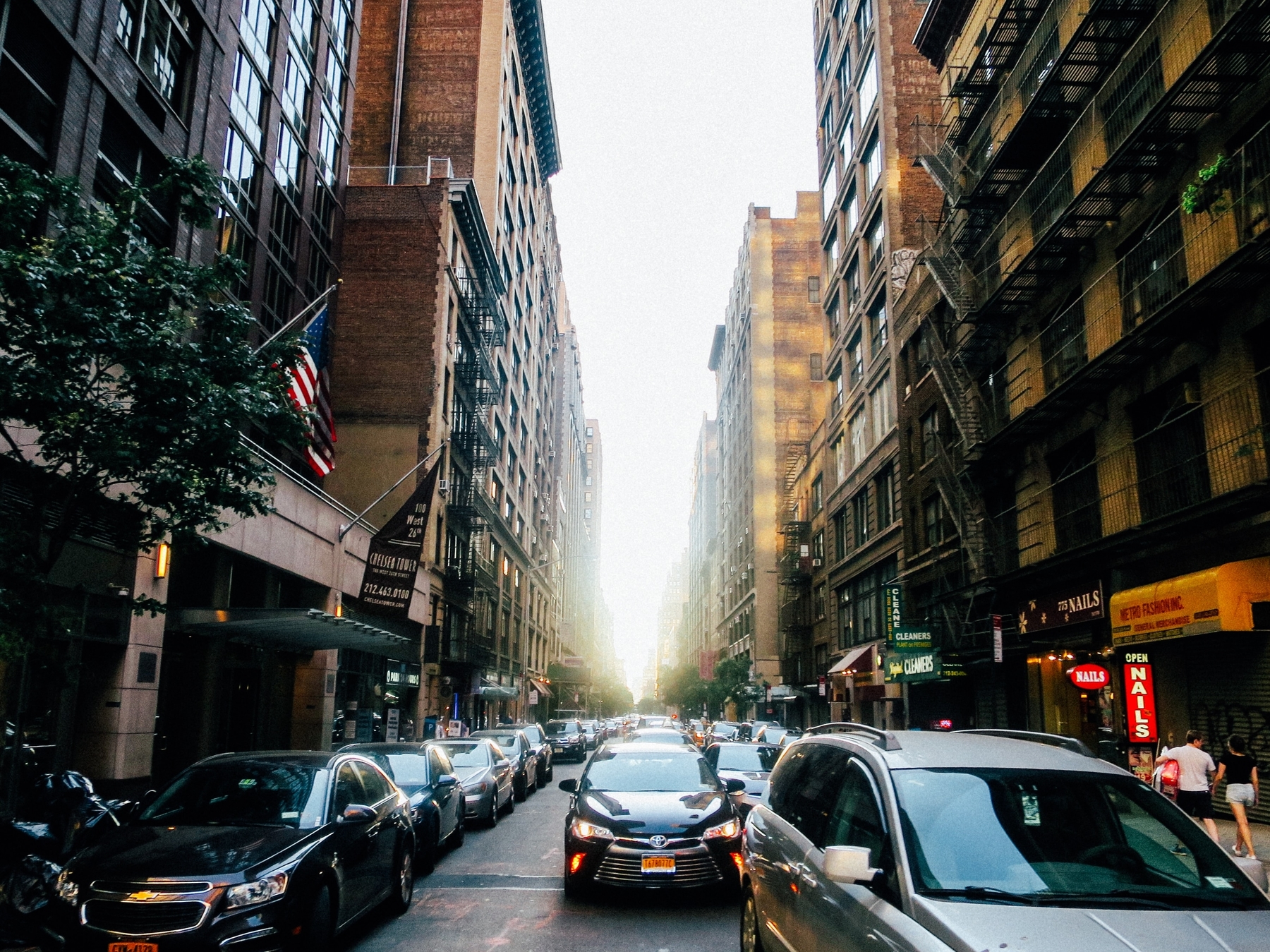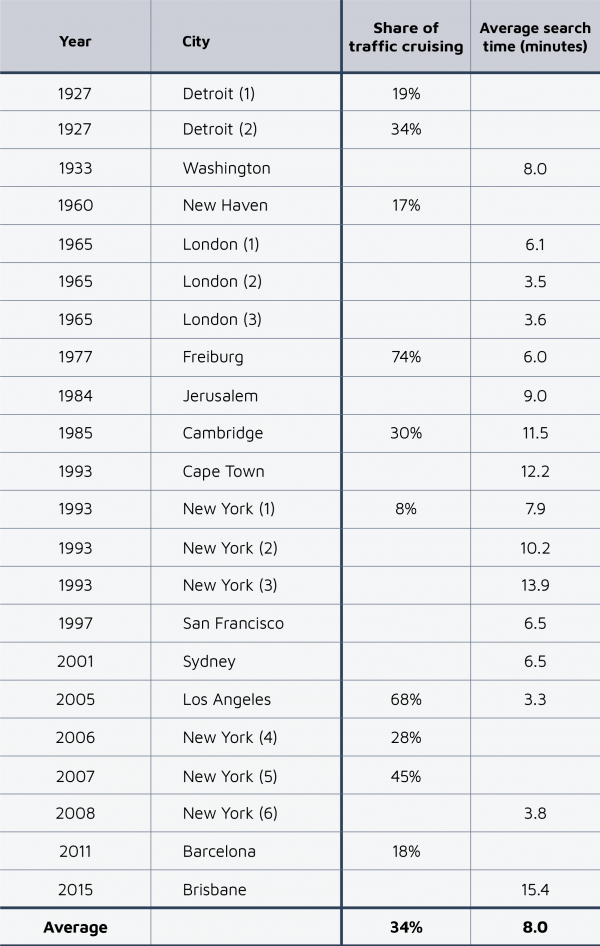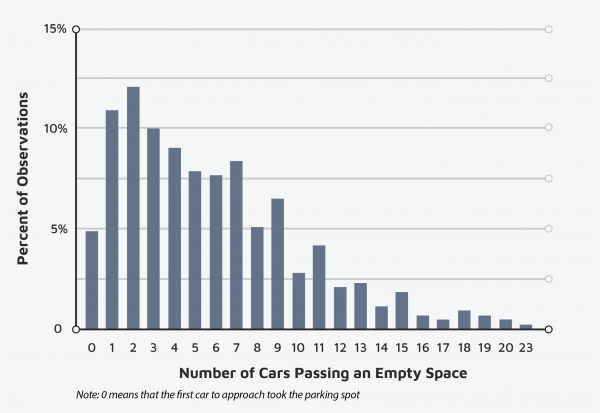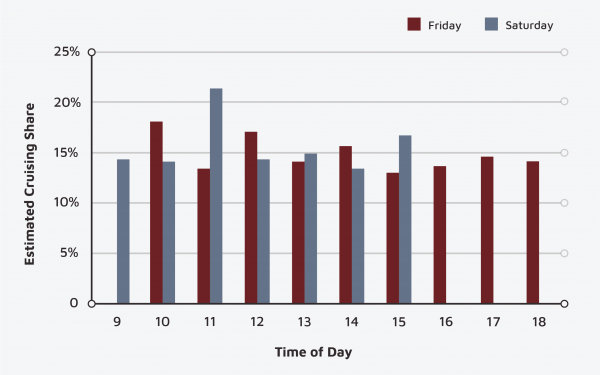
How Much Traffic is Cruising for Parking?
A new way to measure curbside congestion
On a congested city street where all the curb spaces are occupied, some of the traffic is probably searching for curbside parking. This cruising for parking creates a moving queue of cars waiting for vacancies but it is difficult to know how many cars are in the queue because the cruisers are mixed in with other cars that are traveling to destinations.
Cruising for parking stems from underpriced curb spaces. If prices are too low and no curb spaces are vacant, drivers searching for parking congest traffic, waste fuel, and pollute the air. Conversely, if prices are too high and many curb spaces are vacant, businesses lose customers, employees lose jobs, and cities lose tax revenue. Consequently, pricing for curb parking should follow the Goldilocks principle. The right price is the lowest price that keeps one or two spaces open for convenient access on every block so that any driver willing to pay will find a place to park.
Measuring cruising
How much traffic stems from cruising for parking? Table 1 summarizes the results of 22 studies of cruising in 15 cities on four continents, dating back to 1927. According to these findings, cruising for parking accounted for between 8 and 74 percent of traffic in the areas studied, and the average time to find a curb space ranged between 3.5 and 15.4 minutes. On average, 34 percent of cars were cruising, and the average time it took to find a space was eight minutes. However, these results do not represent all city streets because researchers tend to study cruising only where they expect to find it: on downtown streets where traffic is congested and all the curb spaces are occupied. Despite this selection bias, these studies do show that searching for curb parking has wasted time and fuel for decades.
Table 1. Cruising for Parking

Cruising is a variable, not a constant. For example, a study of traffic in central Zurich found that the share of cars cruising varied between 20 and 70 percent from 11 a.m. to 4 p.m. There may be an average share of cruising traffic on a particular street throughout the day, but that average does not predict cruising at any particular time or location, and it certainly does not apply to a whole city. These averages do not suggest that a third of all traffic is cruising for parking. On streets with plentiful open curb spaces, no cars are likely to be cruising. The share of traffic that is cruising can also change from one minute to the next, just as traffic volumes shift throughout the day.
Understanding how much traffic is caused by cruising for curb parking is important because new demands are overloading the curb. The growth of e-commerce has increased the demand for loading zones. Uber and Lyft have increased the demand for curb space to pick up and drop off passengers. Traffic congestion has increased the demand for dedicated bus lanes. Cyclists want bike lanes and pedestrians want wider sidewalks. The curb is the new urban frontier, and parking may no longer be the most productive use of this space.

The curb is the new urban frontier, and parking may no longer be the most productive use of this space.

A new way to estimate cruising traffic
The studies in Table 1 used three main methods to study cruising for parking. They either observed cars in the traffic flow (Detroit, Freiburg, Los Angeles), interviewed drivers who had parked at curbs or were stopped at traffic lights (Barcelona, Brisbane, Cape Town, Los Angeles, New Haven, New York), or conducted park-and-visit tests (Cambridge, London, New York). Unfortunately, these research methods are labor-intensive, time-consuming, expensive, and hard to replicate.
We propose a simpler way to estimate the share of traffic that is cruising for parking on a congested street where all of the curb spaces are occupied. We do this by observing how many cars pass a newly vacated space until a driver parks in it. If, for example, the first or second driver who approaches a newly vacated curb space always parks, it suggests that most of the traffic is cruising for parking. But if many cars pass by before one takes the vacated space, we can assume that most of the traffic is not cruising.
To determine the amount cruising for parking using this method, we employ a probability distribution where each observation of cars in traffic has only two possible outcomes: parking or passing. In a large sample, if the first driver who approaches a newly vacated space always takes it, all of the traffic is probably cruising. If an average of three cars pass the space before a car takes it, then about a third of the traffic is probably cruising. And if an average of 10 cars pass before a car takes it, then 10 percent of cars are probably cruising.
An example
Suppose we have 20 separate observations of how many cars pass a newly vacated parking space before a car takes it and find:
- In 10 of the tests, the first car to approach the open space takes it.
- In five of the tests, the second car to approach the open space takes it.
- In the remaining five tests, the third car to approach the open space takes it.
To estimate the share of cars cruising we divide the number of cars passing the vacant spaces (35 total across all observations) by the number of observations (20); in this case, 57 percent of the traffic is cruising for parking.
A German case study
Video sensors can be used to monitor traffic and measure the number of empty and occupied parking spaces on a block. The cameras are mounted on lamp poles or traffic signals between 20 and 40 feet above the ground, and can observe up to 30 parking spaces each. The cameras have onboard data-processing capabilities that calculate the share of vacant curb spaces every two or three seconds with the goal of providing real-time measures of the availability of open curb spaces throughout the day. A fortunate byproduct of these new camera systems is that the video sensors also record the traffic and parking occupancy on each street throughout the day. We were able to analyze these video measurements through Cleverciti, a firm that provides sophisticated camera-based analyses of parking occupancy in many cities. We then applied our formula to the data to estimate how many cars in a given area are cruising for parking.
In September 2017, Cleverciti analyzed the video records of parking and traffic on 12 streets in central Stuttgart, Germany, from 9 a.m. to 6:30 p.m. Whenever a camera detected a new open parking space, it counted the number of cars that passed before another car occupied it. Over the course of the study’s two days, there were 876 instances of newly vacated parking spaces.
Figure 1. Often, few cars approach an open parking spot without taking it

Figure 1 shows that few or no cars often passed by a curb parking vacancy without parking in it. On the first day’s observations, we estimated that 15 percent of the drivers in traffic were cruising for parking. On the second day’s observations (not shown here), we estimated that 16 percent of those cars in the traffic flow were cruising for parking.
Traffic congestion is a nonlinear phenomenon, meaning that small additions to or reductions in traffic can have outsized effects on vehicle flow, so removing 15 percent of the cars in traffic could greatly reduce congestion. And because a car waiting in traffic while another driver is leaving (or preparing to leave) a space is effectively double-parked, reducing cruising could substantially reduce congestion.
We also estimated the share of traffic cruising during each hour during the day. Figure 2 shows that cruising varied surprisingly little during the day (the observations started and ended earlier on Saturday).
Figure 2. Share of traffic that is cruising for parking in Stuttgart, September 1-2, 2017

Reducing cruising
Setting the right price for curb parking is the simplest, quickest, and cheapest way to reduce time spent cruising for parking. The benefits of reducing cruising are substantial — saving time and fuel, reducing traffic congestion and air pollution, and preventing traffic injuries. Cities will also raise public revenue from the curb parking.
The technology used to measure parking occupancy and adjust parking prices is rapidly improving. Better and cheaper technology will allow more cities to adjust parking prices according to demand, and thus reduce the harm that cruising causes. Developing a simple way to estimate the share of traffic that is cruising for parking will ultimately help to increase political support for demand-based parking pricing. If measurements show where large shares of traffic are cruising for parking, elected officials may be more willing to adopt demand-based pricing for curb parking to reduce cruising and ease traffic.
Conclusion
Previous measurements of cruising for parking have been expensive, time-consuming, and potentially misleading. But as camera-based parking analysis improves and spreads across cities, counting how many cars pass a vacant parking space before one parks is becoming cheaper and easier. With the appropriate algorithms, cities can begin to measure cruising in real time. This new information will reveal the cruising problem to transportation planners, stakeholders, and elected officials who can use the data to improve their cities’ curb management. Carefully looking at traffic to measure cruising for parking can yield substantial benefits for cities, the economy, and the environment.